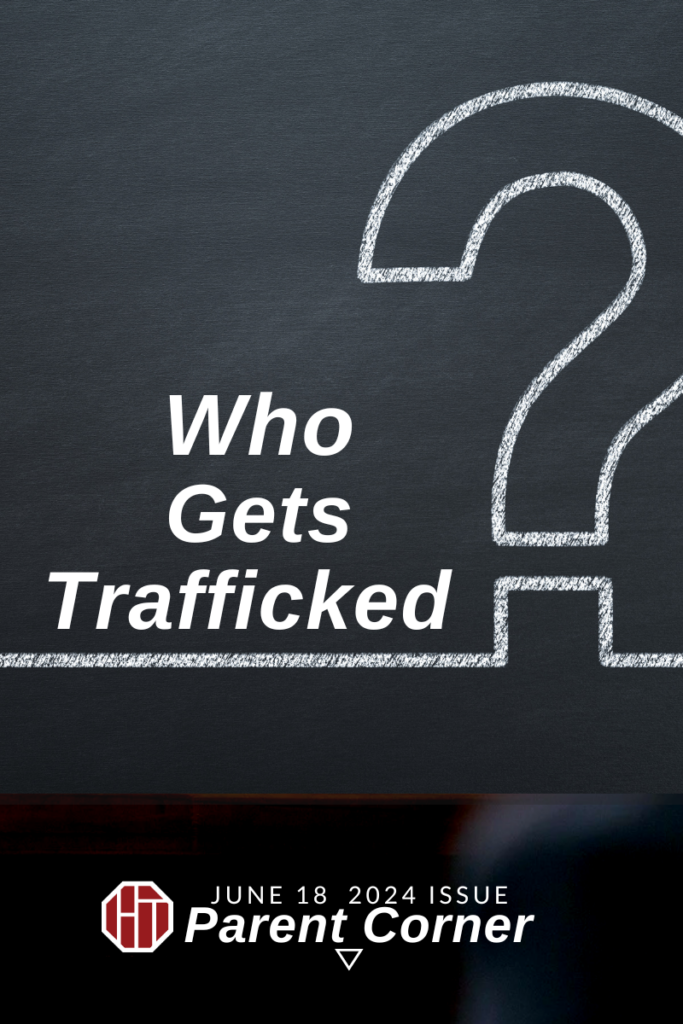Dear Parents,
This month is Pride Month. It is also the
month that holds the commemorative
holiday recognizing the freedom of
enslaved people, Juneteenth. June 21st is
National Indigenous Peoples Day. And all
of these landmarks on the calendar make
me think about who among us is at highest
risk for being taken advantage of? Who should we look after?
Of course, the answer is that we all need to be alert. We all need to look out for one another.
SOME STATISTICS ABOUT
HUMAN TRAFFICKING:
Women and girls make up 54% of
victims of modern-day slavery
(Exodus Road)
Based on a study by the
Human Trafficking Reporting
System, in the United States:
82% of modern slavery is
classified as sex trafficking
11% of modern slavery is
labor trafficking, 7% is
unclassified.
83% of humans trafficked into
the sex trade are U.S.
Citizens
US Citizens are most likely to
be trafficked for sex. Immigrants are most likely to be trafficked into labor.
In both cases, the US plays an active role in modern-day slavery.
40% of girls and women
trafficked into the sex trade
are black (The US population
is 12.2% Black or African
American), 26% are white
(The US population is 63.7%
White). Please take note of
the disparity here!
63% of victims trafficked into
the labor trade are Hispanic,
17% are Asian. (HTRS)
According to the https://bjs.ojp.gov/content/pub/pdf/cshti0810.pdfPolaris Project,
LGBTQ youth are at an increased
risk for trafficking.
40% of homeless youth
identify as LGBTQ
46% ran away because of
family rejection
They are 7.4x more likely to
experience sexual violence
than their heterosexual peers
They are 3-7x more likely to
engage in survival sex to meet
basic needs, such as food and
shelter.
WHAT CAN YOU DO?
Mindfully talk to your children about race, culture, and bias. Here is a helpful resource
for parents:
EmbraceRace.Org – 10 Tips for Teaching and Talking to Kids About Race
KNOW WHAT RED FLAG BEHAVIOR LOOKS LIKE IN KIDS AND ADULTS:
Hesitancy to answer questions, scripted responses
Has experienced threats of harm to self or loved ones
Demonstrates mental health concerns like PTSD, anxiety, self-harm, or depression
Shows signs of physical abuse, neglect, malnourishment, or poor hygiene
Has a debt they cannot pay off
Frequently moves or travels to new cities with different or new acquaintances
Appears to be coerced or controlled
Never left alone
KNOW WHO TO CALL:
911 – Emergency
1.888.373.7888 – National Human Trafficking Hotline
Text INFO or HELP to BeFree (#233733)
“Our loyalties must transcend our race, our tribe, our
class, and our nation, and this means we must develop a
world perspective.” -Dr. Martin Luther King Jr.
In Our Backyard is dedicated to painting an accurate picture of how modern-day
slavery shows up in our backyards. Please talk to your kids about how to look out for themselves and their friends! We volunteered with my daughters and In Our Backyard at the Juneteenth Celebration in our city.
With hope for a better future for our kids,
Gina
Gina Stout
June 2024, Issue #4
–Characteristics of Suspected Human Trafficking Incidents, 2008-2010, Duren Banks and Tracey Kyckelhahn. The US. Department of Justice, April
2011
–Race and Human Trafficking: How this Crime Disproportionately
Affects Ethnic Minorities and Indigenous Persons. The Exodus Road,
January 31, 2022
–United States Census Data – Measuring Racial and Ethnic Diversity for
the 2020 Census, August 4, 2021. Eric Jensen. Nicholas Jones, Lauren Medina, Marc Perry, Ben Bolender, and Karen Battle.
–10 Tips for Teaching and Talking to Kids about Race, Embrace Race,
Moms Rising
–Sex Trafficking and LGBTQ Youth. Polaris Project

